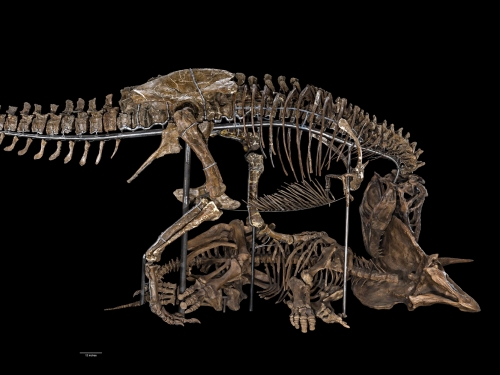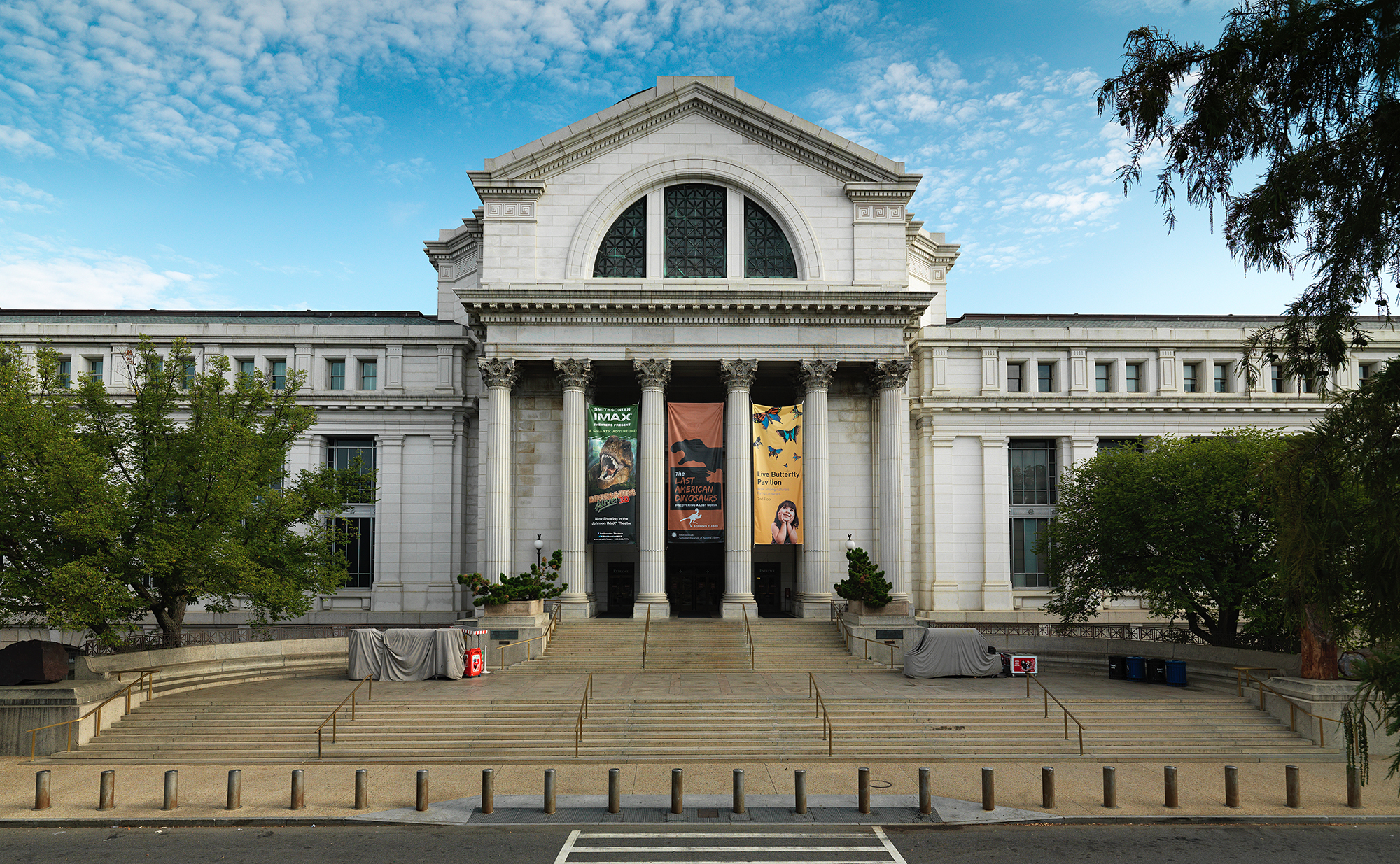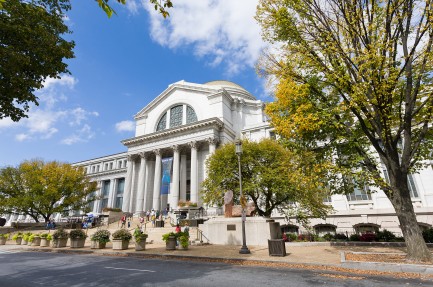
National Museum of Natural History
Director: Kirk Johnson
Total full-time employees: 362
Annual budget (federal and trust) FY 2022: $121.9 million
Approximate number of artifacts/specimens: 148 million
Total museum size: 1.32 million square feet
Public space size: 325,000 square feet
Visits (2022): Approximately 4 million
Website: naturalhistory.si.edu
Background
The Smithsonian’s National Museum of Natural History connects people everywhere to Earth’s unfolding story. Its researchers, scientific collections, free exhibitions and educational programs address fundamental questions, spark curiosity and illuminate the beauty and wonder of the planet. The formal title for Kirk Johnson is Sant Director, in recognition of an endowed gift from the philanthropists, Roger and Vicki Sant.
Research and Staff
The scientific research staff is organized into seven departments: anthropology, botany, entomology, mineral sciences, invertebrate zoology, paleobiology and vertebrate zoology. Museum programs address current topics, such as biological diversity, global climate change, molecular systematics for enhancing the understanding of the relationship between living things, ecosystem modeling and the documentation and preservation of human cultural heritages.
In 2022, the museum’s scientific staff authored 614 scholarly publications.
Collections
The museum holds over 148 million objects and specimens, making it the largest natural history collection in the world. Approximately half of the collection is maintained at the Smithsonian’s Museum Support Center in Suitland, Maryland, which provides state-of-the-art conditions for storage and conservation of collections as well as a library and advanced research facilities.
Permanent Exhibitions
- The Janet Annenberg Hooker Hall of Geology, Gems and Minerals showcases the Hope Diamond and other treasures from the National Gem Collection. It also encompasses re-created mines and galleries that present important research in mineral chemistry and physics; plate tectonics, seismology and the study of volcanoes; and planetary science.
- The David H. Koch Hall of Human Origins explores the epic story of how the human species evolved over 6 million years, adapting and surviving during an era of dramatic climate change. It features more than 285 early-human fossils and artifacts, lifelike full-size reconstructions of several hominid species and 23 interactive experiences, including a morphing station where visitors can see what they would look like as early humans.
- The Sant Ocean Hall demonstrates how the ocean is intrinsically connected to other global systems and the daily lives of people around the world. Features include male and female giant squids and an exact replica of a living North Atlantic right whale.
- Butterflies + Plants: Partners in Evolution demonstrates how butterflies and plants have evolved and diversified together for millions of years. The Butterfly Pavilion (open Tuesday through Saturday) offers visitors the opportunity to be surrounded by hundreds of beautiful butterflies and tropical plants and observe up close how these organisms have evolved and diversified together for millions of years.
- Eternal Life in Ancient Egypt showcases more mummies than have been on display at any time in the museum’s history. The exhibition combines rare artifacts and cutting-edge research tools to illuminate how Smithsonian scientists have pieced together the lives of ancient Egyptians through their burial practices and rituals in preparation for their eternal life.
- The Kenneth E. Behring Family Hall of Mammals tells the story of mammal evolution across 225 million years, with more than 274 specimens on permanent display. Designed with families in mind, the hall includes four discovery zones with hands-on activities that help visitors explore an array of mammal adaptations and habitats around the world.
- The David H. Koch Hall of Fossils - Deep Time invites visitors to travel through ancient ecosystems, witness the evolution of life and get up close to some 700 fossil specimens, including dramatically posed giants like Tyrannosaurus rex, Diplodocus and the woolly mammoth. In a massive, 31,000-square-foot exhibition space spanning 4.6 billion years of Earth’s history, visitors can explore the epic story of how Earth’s distant past is connected to the present and informs its future. The space also features the museum’s FossiLab, a glass-enclosed lab that allows visitors to watch museum paleontologists and trained volunteers extract fossils from rock and make fossil casts and molds.
- The O. Orkin Insect Zoo offers visitors a variety of exhibits and live insects—as well as daily tarantula feedings—and plenty of hands-on activities.
- The Bone Hall features almost 300 vertebrate skeletons. It highlights the diversity and unity of every major group of vertebrates, supporting ideas of evolution and common ancestry. In the exhibition’s mobile app, Skin and Bones, 13 different skeletons come to life through 3D augmented reality and tracking. The app shows how the specimens move or look in life and how their skeletons work.
- African Voices examines the diversity, dynamism and global influence of Africa’s peoples and cultures over time in the realms of family, work, community and the natural environment. It includes historical and contemporary objects from the museum’s collection and commissioned sculptures, textiles and pottery. Video interactives and sound stations provide selections from contemporary interviews, literature, proverbs, prayers, folk tales, songs and oral epics.
Education and Outreach
The museum offers a variety of educational programs for people of all ages. Visitors can engage onsite and online with scientists, collections and research that happens in the lab and in the field.
The museum’s innovative learning space, Q?rius, The Coralyn W. Whitney Science Education Center, inspires students, families and educators to explore their world through a scientific lens by directly interacting with science experts and more than 6,000 specimens, including bones, minerals and fossils. School programs aligned with the Next Generation Science Standards are available for K–12 student groups on weekday mornings by reservation.
The museum’s educators have also developed a new and responsive approach to teachers’ expressed needs for age-appropriate, accessible science content in response to the national education crisis brought on by the COVID-19 pandemic. The award-winning “Transmedia Bundles” are nine extremely rich collections of engaging and accurate digital experiences and content resources, each thematically aligned to core science concepts and skills. A blend of standards-aligned live interactive virtual programs and asynchronous resources, they are a new model for meeting the needs of K–12 teachers and students throughout the country and around the world. Virtual programs include the Smithsonian Science How webcasts and webinars that offer students online access to museum experts through interactive, television-style programs.
The award-winning Youth Engagement through Science (YES!) internship program pairs high school students with Smithsonian experts. Throughout the summer, students and mentors work together inside laboratories and out in the field exploring important scientific questions.
About the Museum
The Smithsonian’s National Museum of Natural History, located at 10th Street and Constitution Avenue N.W., Washington, D.C., is one of the most visited natural history museums in the world. Opened in 1910, the museum houses the world’s largest collection of natural history specimens and artifacts. The museum is open daily (closed Dec. 25) from 10 a.m. to 5:30 p.m. Admission is free. For more information, visit the museum on its website and on Facebook, Twitter and Instagram.
# # #
SI-173-2023
Randall Kremer
202-360-8770
Ryan Lavery
202-633-0826
Jack Tamisiea
202-633-0218




